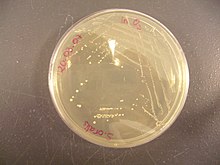
Back عقدية فموية Arabic عقديه فمويه ARZ Streptococcus oralis German Streptococcus oralis Spanish استرپتوکوک اورالیس Persian Streptococcus oralis Dutch
| Streptococcus oralis | |
|---|---|

| |
| Scientific classification | |
| Domain: | Bacteria |
| Phylum: | Bacillota |
| Class: | Bacilli |
| Order: | Lactobacillales |
| Family: | Streptococcaceae |
| Genus: | Streptococcus |
| Species: | S. oralis
|
| Binomial name | |
| Streptococcus oralis Bridge and Sneath 1982[1]
| |
Streptococcus oralis is a Gram positive viridans streptococcus of the Streptococcus mitis group.[2][3] S. oralis is one of the pioneer species associated with eubiotic dental pellicle biofilms, and can be found in high numbers on most oral surfaces.[4][5] It has been, however, found to be an opportunistic pathogen as well.[2]
Individual cells of S. oralis are arranged into characteristic long chains when viewing subcultures under a microscope.[6] It is a non-motile, non-sporulating facultative anaerobe.[7] The optimal culturing temperature range for S. oralis is 35 - 37°C, with growth observed between 10 - 45°C.[7][8][9] Blood agars selective for streptococci, such as brain heart infusion blood agar, are optimal for culturing S. oralis as these plates highlight its α-haemolysis, but nutrient agars such as trypticase soy agar or Wilkins-Chalgren anaerobe agar can support its growth also.[7][8] S. oralis colonies are white, grey, or colourless; translucent; smooth; entire; raised cluster colonies 0.5-2.0 mm in diameter.[9]
S. oralis is catalase negative and oxidase negative.[7] Strains of S. oralis produce neuraminidase and cannot bind α-amylase.[2][7][8] S. oralis is also acid-sensitive, producing alkaline metabolites to ameliorate its niche.[10]
- ^ Parte, A.C. "Streptococcus". LPSN.
- ^ a b c Byers, H.L.; Tarelli, E.; Homer, K.A.; Beighton, D. (2000-03-01). "Isolation and characterisation of sialidase from a strain of Streptococcus oralis". Journal of Medical Microbiology. 49 (3): 235–244. doi:10.1099/0022-1317-49-3-235. ISSN 0022-2615.
- ^ Patterson, Maria Jevitz (1996), Baron, Samuel (ed.), "Streptococcus", Medical Microbiology (4th ed.), Galveston (TX): University of Texas Medical Branch at Galveston, ISBN 978-0-9631172-1-2, PMID 21413248, retrieved 2024-02-26
- ^ Mattos-Graner, Renata O.; Duncan, Margaret J. (2017-01-01). "Two-component signal transduction systems in oral bacteria". Journal of Oral Microbiology. 9 (1): 1400858. doi:10.1080/20002297.2017.1400858. ISSN 2000-2297. PMC 5706477. PMID 29209465.
- ^ Borisy, Gary G.; Valm, Alex M. (June 2021). Darveau, Richard; Curtis, Mike (eds.). "Spatial scale in analysis of the dental plaque microbiome". Periodontology 2000. 86 (1): 97–112. doi:10.1111/prd.12364. ISSN 0906-6713. PMC 8972407. PMID 33690940.
- ^ "Streptococcus oralis". microbe-canvas.com. Retrieved 2024-02-26.
- ^ a b c d e "ABIS Encyclopedia". tgw1916.net. Retrieved 2024-02-26.
- ^ a b c "Streptococcus oralis - microbewiki". microbewiki.kenyon.edu. Retrieved 2024-02-26.
- ^ a b Hardie, Jeremy M.; Whiley, Robert A. (2006), Dworkin, Martin; Falkow, Stanley; Rosenberg, Eugene; Schleifer, Karl-Heinz (eds.), "The Genus Streptococcus—Oral", The Prokaryotes: Volume 4: Bacteria: Firmicutes, Cyanobacteria, New York, NY: Springer US, pp. 76–107, doi:10.1007/0-387-30744-3_2, ISBN 978-0-387-30744-2, retrieved 2024-02-26
- ^ Zhu, Yimei; Wang, Ying; Zhang, Shuyang; Li, Jiaxuan; Li, Xin; Ying, Yuanyuan; Yuan, Jinna; Chen, Keda; Deng, Shuli; Wang, Qingjing (2023-05-18). "Association of polymicrobial interactions with dental caries development and prevention". Frontiers in Microbiology. 14. doi:10.3389/fmicb.2023.1162380. ISSN 1664-302X. PMC 10232826. PMID 37275173.